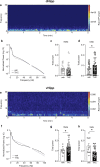Adolescent Δ-9-tetrahydrocannabinol exposure induces differential acute and long-term neuronal and molecular disturbances in dorsal vs. ventral hippocampal subregions
- PMID: 36402837
- PMCID: PMC9852235
- DOI: 10.1038/s41386-022-01496-x
Adolescent Δ-9-tetrahydrocannabinol exposure induces differential acute and long-term neuronal and molecular disturbances in dorsal vs. ventral hippocampal subregions
Abstract
Chronic exposure to Δ-9-tetrahydrocannabinol (THC) during adolescence is associated with long-lasting cognitive impairments and enhanced susceptibility to anxiety and mood disorders. Previous evidence has revealed functional and anatomical dissociations between the posterior vs. anterior portions of the hippocampal formation, which are classified as the dorsal and ventral regions in rodents, respectively. Notably, the dorsal hippocampus is critical for cognitive and contextual processing, whereas the ventral region is critical for affective and emotional processing. While adolescent THC exposure can induce significant morphological disturbances and glutamatergic signaling abnormalities in the hippocampus, it is not currently understood how the dorsal vs. ventral hippocampal regions are affected by THC during neurodevelopment. In the present study, we used an integrative combination of behavioral, molecular, and neural assays in a neurodevelopmental rodent model of adolescent THC exposure. We report that adolescent THC exposure induces long-lasting memory deficits and anxiety like-behaviors concomitant with a wide range of differential molecular and neuronal abnormalities in dorsal vs. ventral hippocampal regions. In addition, using matrix-assisted laser desorption/ionization imaging mass spectrometry (MALDI-IMS), we show for the first time that adolescent THC exposure induces significant and enduring dysregulation of GABA and glutamate levels in dorsal vs. ventral hippocampus. Finally, adolescent THC exposure induced dissociable dysregulations of hippocampal glutamatergic signaling, characterized by differential glutamatergic receptor expression markers, profound alterations in pyramidal neuronal activity and associated oscillatory patterns in dorsal vs. ventral hippocampal subregions.
© 2022. The Author(s), under exclusive licence to American College of Neuropsychopharmacology.
Conflict of interest statement
The authors declare no competing interests.
Figures





Similar articles
-
l-Theanine Prevents Long-Term Affective and Cognitive Side Effects of Adolescent Δ-9-Tetrahydrocannabinol Exposure and Blocks Associated Molecular and Neuronal Abnormalities in the Mesocorticolimbic Circuitry.J Neurosci. 2021 Jan 27;41(4):739-750. doi: 10.1523/JNEUROSCI.1050-20.2020. Epub 2020 Dec 2. J Neurosci. 2021. PMID: 33268546 Free PMC article.
-
Long-term hippocampal glutamate synapse and astrocyte dysfunctions underlying the altered phenotype induced by adolescent THC treatment in male rats.Pharmacol Res. 2016 Sep;111:459-470. doi: 10.1016/j.phrs.2016.07.008. Epub 2016 Jul 12. Pharmacol Res. 2016. PMID: 27422357
-
Prenatal THC exposure induces long-term, sex-dependent cognitive dysfunction associated with lipidomic and neuronal pathology in the prefrontal cortex-hippocampal network.Mol Psychiatry. 2023 Oct;28(10):4234-4250. doi: 10.1038/s41380-023-02190-0. Epub 2023 Aug 1. Mol Psychiatry. 2023. PMID: 37525013
-
Escalating low-dose Δ9 -tetrahydrocannabinol exposure during adolescence induces differential behavioral and neurochemical effects in male and female adult rats.Eur J Neurosci. 2020 Jul;52(1):2681-2693. doi: 10.1111/ejn.14598. Epub 2019 Nov 9. Eur J Neurosci. 2020. PMID: 31626712 Review.
-
Cross-generational THC exposure alters the developmental sensitivity of ventral and dorsal striatal gene expression in male and female offspring.Neurotoxicol Teratol. 2016 Nov-Dec;58:107-114. doi: 10.1016/j.ntt.2016.05.005. Epub 2016 May 21. Neurotoxicol Teratol. 2016. PMID: 27221226 Free PMC article. Review.
Cited by
-
Cannabinoid CB1 receptor-sensitive neurodevelopmental processes and trajectories.Mol Psychiatry. 2025 Aug;30(8):3792-3803. doi: 10.1038/s41380-025-03057-2. Epub 2025 May 19. Mol Psychiatry. 2025. PMID: 40389627 Free PMC article. Review.
-
The Impacts of Adolescent Cannabinoid Exposure on Striatal Anxiety- and Depressive-Like Pathophysiology Are Prevented by the Antioxidant N-Acetylcysteine.Biol Psychiatry Glob Open Sci. 2024 Jul 20;4(6):100361. doi: 10.1016/j.bpsgos.2024.100361. eCollection 2024 Nov. Biol Psychiatry Glob Open Sci. 2024. PMID: 39257692 Free PMC article.
-
Adolescent female rats are resistant to the affective and cognitive impacts of Δ9-tetrahydrocannabinol exposure despite long-lasting molecular and neuronal disturbances in the hippocampal-hypothalamic network.Psychopharmacology (Berl). 2025 May 28. doi: 10.1007/s00213-025-06817-8. Online ahead of print. Psychopharmacology (Berl). 2025. PMID: 40434481 No abstract available.
References
-
- Krebs MO, Kebir O, Jay TM. Exposure to cannabinoids can lead to persistent cognitive and psychiatric disorders. Eur J Pain. 2019;23:1225–33. - PubMed
-
- Gobbi G, Atkin T, Zytynski T, Wang S, Askari S, Boruff J, et al. Association of cannabis use in adolescence and risk of depression, anxiety, and suicidality in young adulthood: a systematic review and meta-analysis. JAMA Psychiatry. 2019;76:426–34. doi: 10.1001/jamapsychiatry.2018.4500. - DOI - PMC - PubMed
Publication types
MeSH terms
Substances
LinkOut - more resources
Full Text Sources

